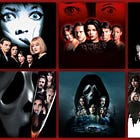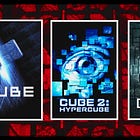Run The Series: 28 DAYS LATER
An absolutely non-objective look back at where the series began, and looking forward to where it may go from here.
28 DAYS LATER (2002)
★★★★★
- “So, know what I was thinking?”
- “You were thinking that you'll never hear another piece of original music ever again. You'll never read another book that hasn't already been written. Or see a film that hasn't already been shot.”
28 Days Later would've gotten five stars from me anyway, just by virtue of it being my life-changing introduction to Godspeed You! Black Emperor, back when I first saw the film on DVD when I was eleven or twelve, and I was thoroughly blown away by the power of their music1 during the iconic, Day of the Triffids-homaging scene of Cillian Murphy wandering the desolately empty, hauntingly quiet streets of post-apocalyptic London.
But outside of that fact, 28 Days Later continues to hold a special place in my horror-loving heart because it's just so damn good. I've seen it too many times for the jumpscare jolts to work on me anymore, but back in the day, the way the Rage-infected fast zombies were depicted - through Danny Boyle's visually inventive direction, Anthony Dod Mantle's dynamic, beautifully ugly early-digital cinematography, and Chris Gill's rapid-fire editing - was genuinely frightening, the ferocity and velocity of their mindlessly rabid violence shredding one's nerves as hard as John Murphy shredded on his guitar for the 'In A House - In A Heartbeat' theme2 that went on to score a billion movie trailers for years on end.
Even if the standard definition digital video 28 Days Later was shot on looks primitive in picture quality by today's standards, it works in the film's favour to look like clinically brutal CCTV. A feature, not a bug, in capturing the unfolding horrors with the immediacy, and unnervingly familiar intimacy, of a camcorder's low-fi guerilla aesthetic. A home movie from Hell.3
Yet within the limitations of the filming format, Boyle and Mantle still shoot everything with an eye for atmosphere, and occasional impressionism, producing startling imagery that transcends the harshness and chunky pixellation of early-2000's digital video.
The stark bright light at the end of the tunnel, casting terrifying silhouettes of the oncoming infected horde.
The oil painting-esque distortion of the field of flowers.
The gothic aura of the shadows and lightning in the mansion.
The sheer unparalleled wetness to the look of all that pouring rain, and all that spewing blood.
Add to that the superlative selection of music (as to be expected from any Danny Boyle film), the star-making performances from Cillian Murphy and Naomie Harris, the sterling support from Brendan Gleeson and Christopher Eccleston, and the unexpected twists and turns of the screenplay from Alex Garland (whose thematic obsessions and authorial stamp that run throughout his entire filmography - i.e. humanity's propensity for self-destruction; hope vs. nihilism; toxic masculinity; violent militarism; etc - are present and accounted for, even right down to having a third act people often complain is weaker than everything that had come before it), and you have a recipe for one of the most legitimately groundbreaking horror movies of the 21st century, which never fails to absorb and enthral me with its unique magic over two decades later.
28 WEEKS LATER (2007)
★★★★
“Abandon selective targeting. Shoot everything. Targets are now free. We've lost control.”
Acting as the Aliens to 28 Days Later’s equivalence to Alien, Juan Carlos Fresnadillo’s 28 Weeks Later follows up Danny Boyle’s original modern horror classic by ramping up everything in scale, ambition, hordes of lethal enemies, and explosive military firepower.
At nearly double the budget (from $8 million to $15 million), and with four credited screenwriters (none of whom are Alex Garland), 28 Weeks Later trades its predecessor’s procedural and psychological micro focus on a small band of survivors navigating a pandemic-ravaged England, and expands into a more macro disaster thriller/action-horror involving an excess of people ready to be turned into cannon fodder, once the inevitable return of the virus starts taking hold of the populace again. Snipers, machine guns, flamethrowers, firebombs, and attack helicopters are the order of the day, all of which also ties in to the film’s then-contemporary commentary on post-9/11 military occupation, and the War on Terror. This political subtext isn’t the most incisive of indictments, if even it was intended to act as one, but the reading is there for those who want to go looking for it.
Among the ranks of the American military overseeing the UK’s attempted return to normalcy, via the quarantined safe zone on London’s Isle of Dogs, is a trifecta of actors who were on the come up at the time, becoming even bigger stars not long after the film came out.
Idris Elba was already known for his role in The Wire, and as I learned from the DVD’s special features back in the day, there were many in the cast and crew who had only ever heard him talk in an American accent, including in this very film, so it came as a surprise to them when they found out he was a London lad.
Rose Byrne had a banger year in 2007, appearing in the star-making hat trick of Sunshine, 28 Weeks Later (the second of her two Danny Boyle-related productions), and the TV show, Damages, alongside Glenn Close.
And then, there’s Jeremy Renner. This film acted as my introduction to the man, playing a soldier character not too dissimilar to the role that would catapult him into stardom just a couple of years later in Kathryn Bigelow’s The Hurt Locker, after which came Marvel, Bourne, Mission: Impossible, and, of course, his biggest claim to fame, the Jeremy Renner App.
Harold Perrineau is also one of the American army characters, but since he was already a well established actor by that point, via his work in Romeo + Juliet, The Matrix Reloaded / Revolutions, and Lost, he was actually one of the biggest names among this cast at the time, alongside Robert Carlyle.
Carlyle, meanwhile, is at the forefront of the story for the first half, as the (rightfully) guilt-ridden father to the real protagonists of the film - the siblings, Andy and Tammy, played by 12 year-old Mackintosh Muggleton, and 17 year-old pre-stardom Imogen Poots. (When I first saw 28 Weeks Later all those years ago, my 14 year-old self was, needless to say, immediately infatuated with her.)
Acting as the heart of the film - since Carlyle’s character nullifies much sympathy we as an audience could have had for him after the act of cowardly betrayal he commits in the film’s breathless, heart-pounding prologue - Muggleton and Poots (the most whimsical law office there never was) are a naturalistic and believable pair, not to mention both significantly better child actors than Megan Burns was as Hannah in the first film.4
For his part, Fresnadillo - hired off the strength of his film, Intacto, which I in turn then bought on DVD (though still haven’t watched) off the strength of his work in 28 Weeks Later - follows in Boyle’s directorial footsteps with vigorous aplomb.
Maintaining the frenetic camera movements and jittery high frame rate style of capturing the Rage zombies’ headlong sprints into rabid violence, Fresnadillo and cinematographer Enrique Chediak add the comparative luxury of shooting on 16mm film, rather than the consumer-grade standard-definition digital video Anthony Dod Mantle worked wonders with previously. This means the sequel gets to have its cake and eat it too, by making the film still look super grainy and grimy and gritty, in keeping with the guerilla spirit of the original, while also having the ability for the movie to hold up much better in its visual fidelity and picture quality for future remasters of the film print, which is something 28 Days Later can never do, by the very virtue of the low-res medium it was shot with in the first place. As a result, 28 Weeks Later has the rough and raw documentary aesthetic template established in Days, while also being able to have both intimate and grand moments of cinematic beauty that look great because they were captured on celluloid.
John Murphy makes a triumphant return to scoring duties, with a gorgeously atmospheric and ferociously exhilarating soundtrack that I urged my mother to buy the album of from iTunes, and that I promptly replayed too many times to count over the intervening years. That he only had two weeks to compose music for the entire film is madness, even though I’m sure his job was made somewhat easier by him reusing many of the pre-written themes he’d already done for the original film. Including the smash hit track that became the defining theme for this burgeoning franchise, ‘In The House - In A Heartbeat’, which 28 Weeks Later makes damn sure you get to hear as many times as possible to satiate your appetite for those ear-blasting, face-melting, speakers-pulverising electric guitars. (In the film, it appears three times. On the album, it also appears three times - specifically on ‘28 Theme’, ‘Don Abandons Alice’, and ‘Leaving England’ - but here, however, ‘28 Theme’ is an album-only variation, with the album as a whole ditching the theme reprise that appears during the outbreak massacre sequence.)
It was this soundtrack, in the same year he delivered the phenomenal ‘Adagio in D Minor’ for Sunshine, that cemented me as a fan of John Murphy from that moment forward.
As an adult many years removed from when I loved the film wholeheartedly as a teen - to the point that, at school, I once used one of the computer rooms at lunchtime to print off an alleged copy of a leaked early draft of the script I found online (that was very different to the final product) - I can appreciate nowadays that 28 Weeks Later isn’t on the same level as the first one. It’s a very conventional sequel in many respects, and with its uptick in gun-toting action, it loses some of the quiet, the quirkiness, the character, and the philosophical themes that underpinned Boyle’s film through Garland’s screenplay. By contrast, Weeks feels like it wants to be a bit more of an Americanised blockbuster, with all the massive bombastic spectacle that entails. Something that can occasionally tip over into ridiculousness, like with the fun-but-silly helicopter gag, which just so happened to be insanely akin to a similar helicopter gag in Robert Rodriguez’s Planet Terror, coincidentally released the exact same year. (In either case, 2007 was not a safe time for John Landis to be watching movies if he didn’t want to be reminded of… well, you know.)
Yet even in spite of its excesses, and some major plot contrivances it asks you to swallow, Fresnadillo’s film still thrills in its own special way because the sequences of suspense and frantic chaos are so immersively fraught with peril, nerve-wracking energy, nightmarish imagery, and imaginative photography (like attaching the camera to a zombie’s back as it runs through the streets, or the night-vision sniper scope), that you can’t help but be swept up in the maelstrom that unfolds.
Plus, like many other virus-related films, the COVID era has unfortunately only helped make stupid character decisions in these sorts of movies - including 28 Weeks Later - all the more infuriatingly plausible in retrospect, since we now know not to underestimate people’s selfishness and idiocy in the face of blind panic brought on by a rampaging contagion, even if their choices would be destructive to themselves and to others. So that’s something.
Now, let me tell you, when this film was coming out, I was taken aback in abject surprise by its sudden existence. The first I knew of it was by its poster appearing on the back of an issue of Empire Magazine, within which was also a feature written about the film’s production ahead of its imminent release. For all I expected of it, I dreaded that 28 Weeks Later would be a straight-to-DVD cash grab, made with none of the original’s love and care. So it was a pleasant shock to find that it did get a theatrical release, with decent reviews, profitable box office, and a movie I ended up liking almost as much as the first. And since this was now a bonafide franchise, I expected Boyle and Garland’s teased follow-up of 28 Months Later to arrive within a few years.
So I waited. And I waited. And I waited. And I waited…
28 YEARS LATER (2025)
★★★★
“There are many kinds of death. Some are better than others.”
And I waited.
And so much time passed, it seemed like there’d never be another film in the series again. Perhaps we just had to live with the implications of 28 Weeks Later’s final shot maybe meaning there was no more story to tell.
But even though 28 Months never came to pass, a belated but welcome change in behind-the-scenes fortunes meant that, at very very very long last, we were going to find ourselves in exciting new territory. 18 years after the second film, 23 years after the first, and no longer in the realm of 28 Months, but now a jaw-dropping 28 Years Later.
And oh boy, who could have ever predicted the places this film would take us, compared to everything that came before?
Did you expect the returning duo of Danny Boyle and Alex Garland to make their long-awaited comeback to the 28 Days Later universe with a sequel that would just replay all the hits, and give you everything you thought you wanted from it? Because if so, then there’s a good chance 28 Years Later will blindside those who are unprepared for the stranger aspects of what the film’s going for. Especially with regards to the path it’s beginning to chart in its ambitions as the beginning of a new trilogy.
A good example and barometer of this recalibration of expectations comes in the form of the music.
See, if you were hoping for 28 Years Later to bring back John Murphy’s ‘In The House - In A Heartbeat’ theme from the first film (and believe me, I certainly was, too), even in spite of his absence from composing duties, then you may be disappointed to hear that none of Murphy’s music is returned to in this film.
Does this mean that maybe they’re holding back from using the old theme everyone knows, and saving it for one of the next instalments in this trilogy (such as next year’s The Bone Temple), so that it’ll have a greater cathartic impact when it finally kicks in? Like a delayed gratification kind of thing, à la the way that Twin Peaks: The Return held off from reprising ‘Laura Palmer’s Theme’ for multiple episodes, and then when Angelo Badalamenti’s score finally reappeared, it hit you so much harder?
Or do Boyle and Garland intend to completely withhold the expected comforts of the Murphy music we know, thereby forcing us to accept the change of the new sonic landscapes conjured for these back-to-back films - first by the Scottish progressive hip-hop group, Young Fathers, for this opening salvo to the trilogy, followed by Hildur Guðnadóttir for The Bone Temple?
It remains to be seen. Everything hinges on what happens in the next chapter when it arrives several months after the first, and whether or not both films will be profitable enough for the mooted third instalment to get the green light, and complete this grand saga Boyle and Garland are wanting to tell.
What I can say for certain is this:
Before it was announced that they were 28 Years Later’s composers, I had never heard of Young Fathers before. But if I had watched T2: Trainspotting, Danny Boyle’s other lega-sequel to one of his classic earlier films, back when it came out in 2017, then I might’ve known ahead of time that Boyle and the band had already crossed paths beforehand, back when he used some of their music in that film.
Compared to John Murphy’s defining work on 28 Days and Weeks Later, Young Fathers’ score is a very different beast altogether. Blurring the line between traditional instrumental score, and a handful of actual songs with lyrics and vocals, their collection of cues for the film encompasses experimental electronic soundscapes, jangly indie rock, tribal percussion, manipulated voices, field recordings (including the eerie 1915 reading of Rudyard Kipling’s “Boots” poem that made the trailers so uniquely intense), and a remixed rendition of Richard Wagner’s ‘Vorspiel’ (which you may also remember from Terrence Malick’s The New World, and Werner Herzog’s Nosferatu the Vampyre).
But the crowning achievement of the whole soundtrack, and the thing that made any lingering doubts I may have had about the Young Fathers changeover completely vanquished from memory, thus solidifying their work herein more than worthy of standing as a proud equal to the iconic scores that came before, is the track ‘Remember’. A soaring, achingly poignant composition of overwhelming orchestral beauty, whose context within the story itself during one of the best scenes in any film released this year, makes it all the more skin-pricklingly powerful to revisit afterwards.
There’s a lot about 28 Years Later that I’m still mulling over as I gather my thoughts about the feverish, hallucinogenic, surreal, disturbing, outrageous, and frankly bonkers twists and turns it takes. Particularly with how it relates to the abrupt cliffhanger (ending at a point where I thought there was still half an hour of film remaining, which on the plus side shows how fast it felt like the time flew by), leaving me exceedingly curious to see what will happen in Nia DaCosta’s imminent continuation coming in early 2026.
But given that its vibes are more in line with the risk-taking, unapologetically unusual, yet emotionally fulfilling likes of Twin Peaks: The Return and The Matrix Resurrections, rather than the safely formulaic legacy sequel ilk of The Force Awakens or Top Gun: Maverick, I can’t help but appreciate and applaud 28 Years Later for being so utterly unlike anything I could have imagined, and conjuring a story that took me places I never knew I wanted to go…
If you enjoyed this edition of Run The Series, you may be interested in perusing the previous instalments of this strand of film franchise retrospectives, which you can check out down below:
Though I wouldn't find out until several years later that that pulse-pounding piece of music came from GY!BE, as I long assumed it was another one of John Murphy's compositions from his thrilling original score, alongside his equally earth-shakingly awesome track, 'In The House - In A Heartbeat', which became the de facto theme for the 28 Days Later series as a whole. Bear in mind that during the 2000's, there was no Shazam to easily search for the music, and as a child, I wasn't on the internet enough to know to look up such information from IMDb or whatever, nor would I have found it helpful to watch 'til the end of the credits to see the list of songs licensed for use in the film, since I wouldn't have been able to look the tracks up anywhere to listen to them. So it wasn't until around 2008 or '09 or so that I finally found out that that music I'd been obsessed with tracking down, ever since I first watched 28 Days Later's unforgettable opening sequence, was never on the soundtrack album, because it was never composed by John Murphy, but was instead actually a segment of the 10+ minute track, 'East Hastings', from Godspeed You! Black Emperor's album, F♯ A♯ ∞. (This track was also used in the Flash-animated web-comic series, Broken Saints, but I didn't recognise it as such until much later.) Once I was clued into this knowledge about 'East Hastings', I asked my mother to buy the album from iTunes (as Spotify wasn't ubiquitous yet, Apple Music was years away from existence, ad-free music streaming services in general weren't a thing, I didn't have money of my own, nor a computer of my own, and I had yet to learn how to go sea-faring on the internet's high seas to download music to listen to at my leisure), and from there, I became a GY!BE fan for life.
In my review of Sunshine, I gave an abridged history of the times when Murphy's 'Adagio in D Minor' was copied by other movies and TV shows. So in that spirit, I'd also like to make mention of the times I noticed when 'In The House - In A Heartbeat' got similarly copy-and-pasted. Murphy repurposed the track pretty much verbatim to act as Big Daddy's theme in Matthew Vaughn's Kick-Ass, while the rest of the score was built off of remixing and extrapolating upon his 'Adagio'. But in unofficial capacities, where it was used as temp music, and composers were likely saddled with remaking 'In The House...' into legally distinct copies they couldn't get sued for, Marco Beltrami replicated it for the Season 1 finale of the 2009 V reboot (the very same episode he also did a version of 'Adagio'), while Joseph LoDuca replicated 'In The House...' in a Season 1 episode of Spartacus. You can find the latter example yourself; just look up the Spartacus: Blood and Sand soundtrack album on your streaming platform of choice, and find the track entitled 'Different Sword'. The resemblance? Pretty bloody blatant!
A phrase that was also used to describe the look of Marc Price's film, Colin, an even-lower-budget British zombie film from later that decade, which was made for a whopping £45. (No, that isn’t a typo missing some zeroes on the end. I mean literally forty-five quid.) I really thought it would go on to be a cult classic by now, but Colin seemed to fade from memory as quickly as it arrived in 2009. I still have it on DVD, so I ought to give it a rewatch sometime soon.
(Burns wasn’t completely terrible, don’t get me wrong, but I’m afraid I must admit that I’ve always found her to be the weakest part of 28 Days Later, who has the lion’s share of, shall we say, dubious line deliveries. Obviously, one can and should cut her some slack since she was just a kid, and in any case, she retired from acting right after anyway, but I’m just speaking my truth.)















Oh, INTACTO is a DIABOLICAL film. To be honest, it feels a lot like a proto-Chris Nolan movie, for what it's worth.
Fromtheyardtothearthouse.substack.com